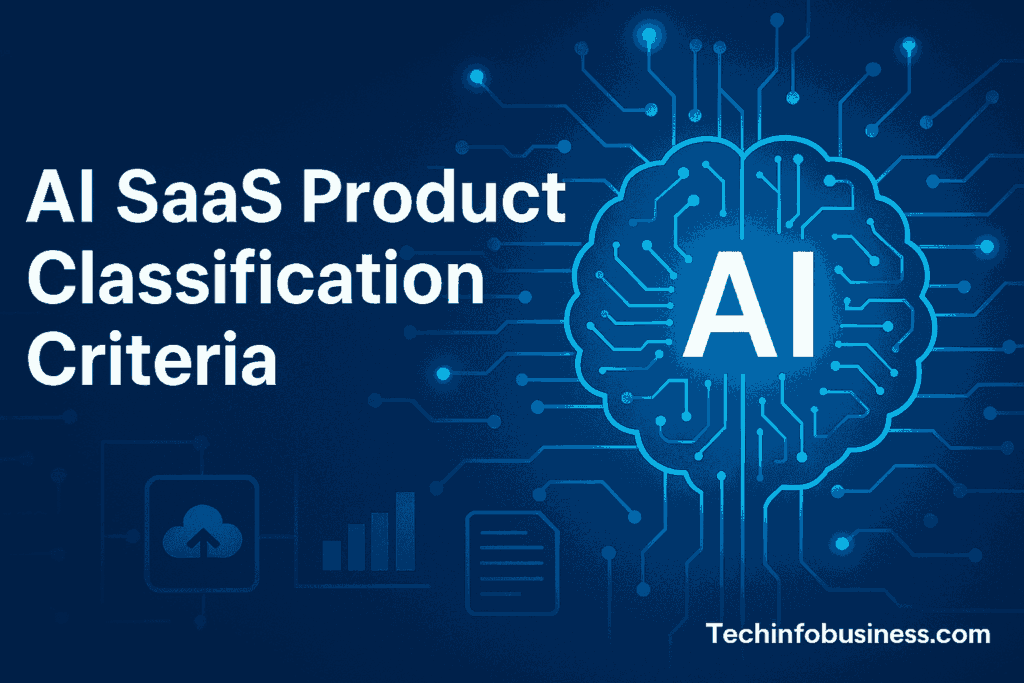Artificial Intelligence (AI) is now embedded in virtually every layer of cloud-based software systems. The rapid evolution of AI has transformed how Software-as-a-Service (SaaS) products are developed, delivered, and consumed. With the convergence of these two technologies—AI and SaaS—there arises a critical need for a robust classification system to distinguish, evaluate, and benchmark various products in this domain.
This article will provide a comprehensive guide to AI SaaS product classification criteria, offering structured insights for developers, businesses, investors, and end users who aim to understand and navigate the complex AI SaaS ecosystem effectively.
Understanding AI SaaS Products
AI SaaS products are software solutions delivered over the cloud that integrate AI capabilities to automate tasks, extract insights, and offer personalized user experiences. Unlike traditional SaaS products, AI SaaS continuously evolves by learning from data, thereby improving its efficiency and accuracy over time.
These products span a broad range of industries—finance, healthcare, marketing, logistics, and more—offering services such as intelligent chatbots, automated analytics, fraud detection, and predictive maintenance. Their growing ubiquity makes it necessary to develop standard classification criteria that help stakeholders assess their features, maturity, and applicability.
Why Classification Matters in AI SaaS
Classification serves as a navigational compass in the ever-expanding world of AI SaaS. As new products emerge, it becomes increasingly difficult for users and decision-makers to compare capabilities or determine the best fit for their needs. Classification frameworks serve multiple critical functions:
- Market Segmentation: Helps delineate different categories based on function, industry, or technology stack.
- Product Development Guidance: Developers can target specific classification tiers to benchmark progress.
- Investor Analysis: Investors can better evaluate maturity, potential ROI, and market demand.
- Consumer Clarity: Businesses can make more informed choices based on structured product data.
Without a well-defined classification scheme, the landscape becomes fragmented, leading to misaligned expectations, wasted resources, and stunted innovation.
Core Functional Criteria
One of the primary ways to classify AI SaaS products is based on their core functionality—what they are fundamentally designed to do. AI features can enhance nearly every area of traditional SaaS, but the base category of functionality remains essential.
Here are some core functional categories:
- Customer Relationship Management (CRM): AI-powered CRMs automate customer segmentation, predict churn, and personalize communication.
- Enterprise Resource Planning (ERP): AI integrations support demand forecasting, financial modeling, and supply chain optimization.
- Human Resource Management (HRM): Used for talent acquisition, employee sentiment analysis, and performance tracking.
- Marketing Automation: AI aids in campaign planning, A/B testing, and customer behavior analysis.
- Financial SaaS: Offers predictive analytics, fraud detection, and real-time transaction categorization.
Each of these functions may include different layers of AI involvement, influencing how they’re classified in terms of complexity and innovation.
Level of AI Integration
Another important dimension is how deeply AI is embedded in the product. AI SaaS platforms can be categorized by the level of AI integration, ranging from simple automation to advanced cognitive computing:
- Basic Automation: Uses rule-based logic to perform repetitive tasks.
- Machine Learning (ML)-Enabled: Employs algorithms that improve with data, offering predictive capabilities.
- Natural Language Processing (NLP): Allows the product to understand and generate human language.
- Deep Learning/Cognitive AI: Simulates human decision-making, allowing for complex problem-solving and self-improvement.
- Generative AI: Creates new content or models based on patterns learned from existing data.
Each level comes with unique technical requirements, such as model training, data ingestion, and real-time processing capabilities.
Data Strategy and Dependency
Data is the engine of any AI system. Therefore, evaluating a SaaS product’s data strategy is a key criterion in classification. This includes:
- Data Input Types: Text, voice, video, images, structured vs. unstructured data.
- Data Volume Requirements: Is the product designed for big data environments or smaller datasets?
- Real-time vs. Batch Processing: Can the system ingest and respond to data in real-time?
- Data Privacy and Compliance: Does it adhere to GDPR, HIPAA, or other industry-specific standards?
- Model Feedback Loops: Does it continuously learn from user interaction and update its models accordingly?
A SaaS product with robust data management practices and real-time feedback loops demonstrates higher AI maturity and delivers greater long-term value.
Target User Persona
Every AI SaaS product serves a specific user base, and the classification should reflect that. Broadly, users can be categorized into the following groups:
- Enterprise Clients: These solutions offer high scalability, integration capabilities, and multi-user access. Often designed with compliance and security at their core.
- Small and Medium Businesses (SMBs): These products focus on affordability, ease of use, and plug-and-play functionalities.
- Freelancers and Individual Professionals: Lightweight solutions designed for specific use cases like AI writing assistants or scheduling tools.
- Developers and Data Scientists: Tools offering APIs, model training interfaces, and custom integrations for technical users.
Understanding the target user helps in evaluating the product’s interface, pricing model, support ecosystem, and adaptability.
Industry-Specific Customization
Many AI SaaS products are now being built with vertical integration, targeting specific industries and niches. These tailored solutions provide more effective tools than generic platforms because they address industry-specific challenges. Examples include:
- Healthcare SaaS: Uses AI for diagnostics, treatment planning, and patient monitoring.
- Retail & eCommerce: Offers intelligent product recommendations, inventory forecasting, and customer behavior analysis.
- Finance & Banking: AI is used in fraud detection, risk management, and algorithmic trading.
- Education: Adaptive learning platforms customize content delivery based on student performance.
- Legal Tech: AI for contract analysis, legal research, and case predictions.
Classifying AI SaaS products based on their industry alignment helps assess their domain relevance and regulatory compliance readiness.
Deployment and Architecture
The underlying architecture and deployment model significantly affect an AI SaaS product’s performance, scalability, and ease of integration. Here are some architectural dimensions worth classifying:
- Cloud-native vs. On-Premise: Cloud-native products offer flexibility and continuous updates, whereas on-premise options offer better data control.
- Microservices Architecture: Promotes scalability and modular development.
- Containerization and Orchestration: Supports multi-environment deployments using Docker, Kubernetes, etc.
- API Accessibility: Determines how easily the product integrates with other systems.
- Edge AI Support: Products that support edge devices for decentralized AI computation.
By classifying products based on these parameters, users can better understand the operational complexity and potential integration overhead.
Pricing and Monetization Models
Another practical classification factor is the pricing structure, which directly impacts product accessibility and business scalability. Some common pricing strategies include:
- Subscription-Based: Monthly or annual recurring fees.
- Usage-Based: Charges depend on data consumption or processing volume.
- Freemium Model: Basic features for free with optional premium upgrades.
- Enterprise Licensing: Tailored pricing for large-scale deployments.
- Revenue Sharing: Often seen in platforms that generate profit for users (e.g., AI-generated content monetization).
The pricing model influences user adoption, ROI expectations, and long-term product viability.
Compliance, Security, and Ethical AI
Compliance with legal, ethical, and security standards is essential for any AI-powered platform, especially in sensitive sectors. Classification should consider:
- Regulatory Adherence: GDPR, HIPAA, SOC2, CCPA, and industry-specific laws.
- Ethical AI Practices: Ensuring transparency, bias mitigation, explainability, and accountability.
- Security Protocols: Encryption, access control, data isolation, and breach notification protocols.
- Audit and Governance: Logging mechanisms, version control, and internal governance models.
Products that fail to meet compliance benchmarks pose a risk not only to businesses but also to consumers and the broader ecosystem.
Product Maturity and Roadmap
Finally, the stage of development and product maturity must be part of the classification framework:
- Pre-Launch/Alpha: Still in development, usually available to select testers.
- Beta Stage: Available to public or closed beta testers, with limited functionality.
- Minimum Viable Product (MVP): Operational but lacks full features.
- Fully Commercialized: Actively sold with full support and documentation.
- Continually Evolving: Regular updates, roadmap transparency, and community engagement.
Mature products generally have better support, documentation, and integrations, whereas early-stage solutions may offer innovation but higher risk.
Read More: API Documentation Tools: Empowering Developers with Clarity and Accessibility
Conclusion: Building a Universal Framework for AI SaaS Classification
As AI-powered SaaS solutions continue to revolutionize industries, having a structured framework for classifying these products is no longer optional—it’s a necessity. From core function and AI depth to user focus and compliance, each classification dimension adds clarity, reduces risk, and enables more intelligent decision-making.
The AI SaaS product classification criteria discussed in this article are designed to be both comprehensive and adaptable, catering to the needs of startups, enterprises, investors, and consumers. As the ecosystem matures, these criteria can evolve to accommodate new technologies such as quantum AI, multi-modal models, and decentralized learning systems.
Ultimately, a clear classification system accelerates innovation, fosters trust, and ensures that AI SaaS remains a cornerstone of digital transformation.



